Flora and fauna in Cusco
Cusco is located in the heart of the Andes Mountains. Its mountainous geography is home to a great diversity of plant and animal life. However, this region of Peru also has a tropical ecosystem where many other species inhabit. Learn about the flora and fauna of this region where the Incas settled.
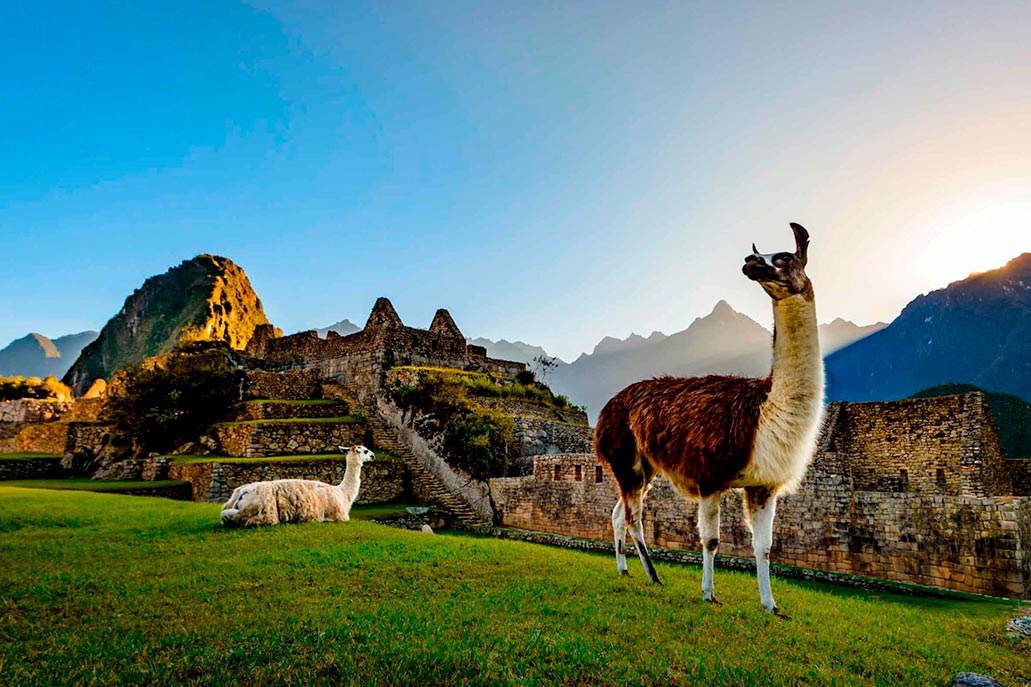
Content
The Andean condor
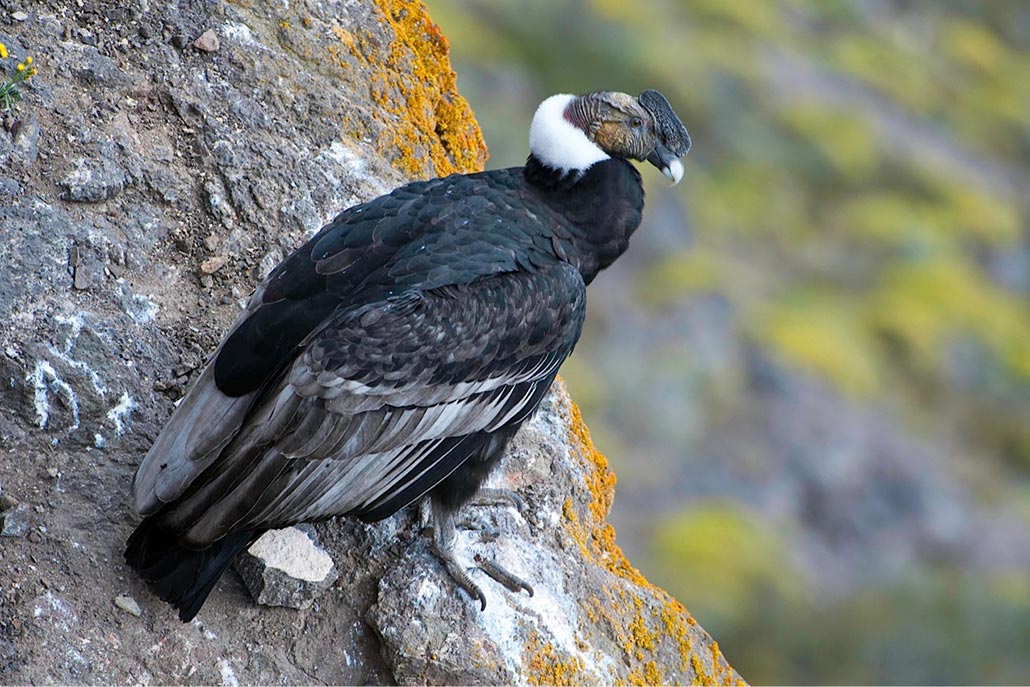
The Andean condor ( Vultur Gryphus) is the largest non-marine flying bird in the world (it can measure 1.42 meters (4.6 ft.) tall and 3.30 meters (10.8 ft.) wingspan. Its natural habitat is the Andes Mountains in South America, encompassing mainly the countries of Peru, Ecuador, Argentina, Chile, Colombia, Venezuela and Bolivia. Belongs to the family ‘Cathartidae’, which feed mainly on carrion. For millions of years, the condor had a leading role in the man of South America. For the Incas the condor was immortal and had the function of communicating the world of the living and the dead.
Description
- Dimensions: The condor can reach a height of 1.42 meters (4.6 ft) and a wingspan of 3.30 meters (10.8 ft).
- Characteristics: The condor has black wings with some white feathers. It has feathers (like a scarf) around the neck. The male is larger than the female and differs by presenting a reddish crest on forehead. They both have a great sense of sight and smell.
- Lifespan: The condor can live 60 years in its natural habitat and 75 years in captivity.
- Habitat: The Andes Mountains of South America (Peru, Ecuador, Argentina, Chile, Colombia, Venezuela and Bolivia).
- Behavior: Condors nest in the most inaccessible peaks of the Andes Mountains. They fly over mountains in search of carrion. They can fly over heights of up to 6 thousand meters above the sea (19,685 ft) although they also descend to the marine coasts.
- Food: Condors are scavengers. They can eat 5 kilos of food a day and can also fast for 1 month.
- Reproduction: Condors are monogamous birds (they choose a mate and keep it for life). On average, they lay 1 egg every two years.
- Threats: The condor is in a ‘Near Threatened’ conservation status due to illegal capture as well as the deterioration of their environment.
Habitat in Cusco
- In Cusco there are several regions where you can appreciate the flight of the condors.
- The ‘Mirador del Cóndor de Chonta’ in the Limatambo district is one of the tourist attractions of the region where you can see several condors flying over the skies of Cusco.
The condor and the Incas
- The condor was considered a sacred bird for the Incas. It symbolized wisdom, strength and intelligence. According to the Inca worldview, this bird communicated the upper world ( Hanan Pacha) with the earthly world to which they belonged ( Kay Pacha).
- The Incas also believed that the condor was immortal. It was said that in old age, the condor ascended to highest mountain peak and dropped into ravines in symbolic death until rebirth in a new life cycle.
- The Incas dedicated several temples and buildings to him in honor of the Andean condor. Maybe one of the The most famous is the Temple of the Condor in Machu Picchu.
- Today, the condor continues to represent a sacred animal for Andean man.
Camelids in Cusco
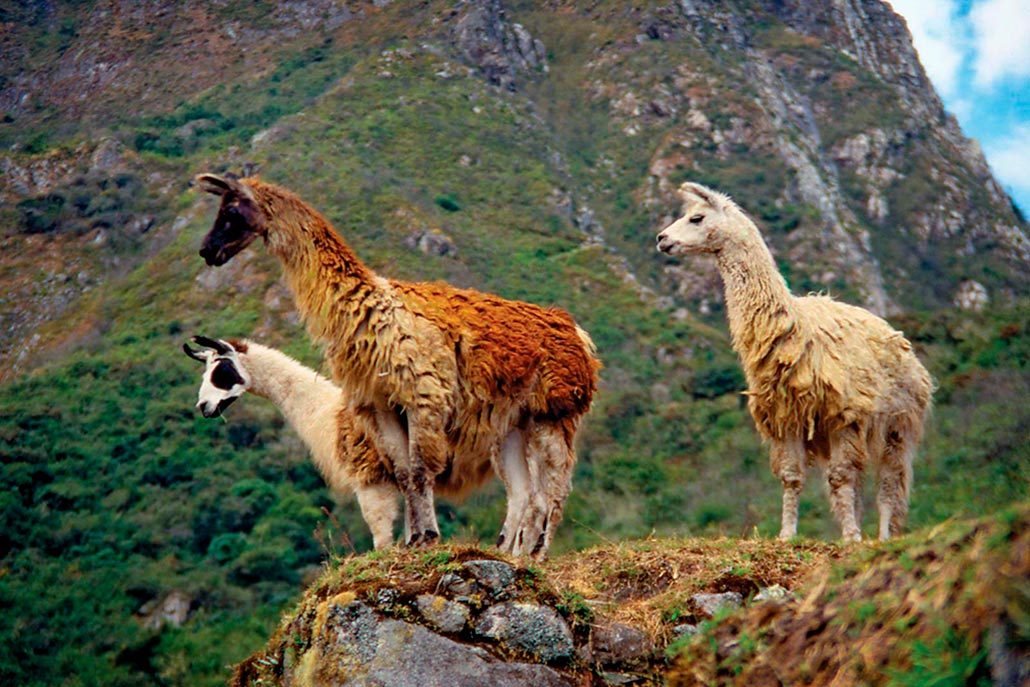
Camelids are a species of mammals belonging to the ‘Camelinae’ subfamily that, in addition to the Andean camelids include camels. In the Andes Mountains of South America (from Patagonia from Argentina to the mountains of Colombia including Chile, Bolivia, Peru and Ecuador).
There are 4 different types of camelids in South America: llamas and alpacas (domesticated camelids) as well like guanacos and vicuñas (non-domesticated camelids). Since the time of the Incas, the wool of the camelids have long been used to manufacture clothing. Today, vicuña wool is one of the most fine on the planet and, like alpaca wool, are exported to the rest of the world.
The Llamas
- Llamas are a species that was domesticated from the guanaco thousands of years ago. Weighs between 130 and 150 kilos (330 pounds) and reach a height of 1.90 meters tall (6.2 ft). The Incas used the Llamas as transport as well as their wool to make clothes. Today the llamas spread across Peru, Colombia, Bolivia, Chile, Argentina and Ecuador.
- The llama had great importance for the Incas and their ancestors. The pre-Inca Mochica culture (al northern Peru) represented the llama in many of his famous ceramics. The Incas used to sacrifice llamas to honor the mountains, the sun and all their gods.
- Today, the llamas continue to serve as transportation. In addition, its wool is commercialized and its meat used of food.
Alpacas
- Alpacas are a species of domesticated camelids that are biologically similar to the vicuña. On average, it reaches a weight of 64 kilos (141 pounds) in adulthood. They also reach a height of 90 centimeters (2.9 ft). There are two types of alpacas (wakaya and suri) whose wool is different mainly because of the texture.
- Alpacas differ from other camelids mainly by the thickness of their wool. exist coats of different colors and textures according to their upbringing. The Incas highly valued the wool of the alpaca. Currently, the people of Cusco export alpaca fiber abroad where it is very valued.
- Alpacas inhabit the current territories of Peru, Bolivia, Argentina, Chile and Ecuador. Also I know They have been breeding in the United States, New Zealand and some European countries.
The vicuñas
- Vicuñas are a species of non-domesticated camelids that are similar to the alpaca. I know It is the smallest species of Andean camelid as they reach a maximum height of 80 centimeters (2.6 ft). and a maximum weight of 50 kilos (110 pounds).
- Vicuñas are characterized by having long and thin legs as well as a beige color with slight variations. They mainly inhabit the highlands of Peru, Bolivia, Argentina, Chile and Ecuador.
- The wool of the vicuña was highly valued since before the Incas who used measured techniques to extract its fiber. However, since the Spanish conquest (and access to firearms), the indiscriminate hunting of vicuñas was drastically reducing the number of the species in South America.
- Currently, the vicuña is protected by the authorities of each country. Thus the species is found in ‘Least Concern’. The sale of their wool is controlled by governments although they already exist many species in the United States, Canada, and Australia.
The guanacos
- Guanacos are a species of wild camelid whose domestication gave rise to the llama. I know characterized by having a black spot on the head as well as its large wingspan of up to 1.9 meters (6.2 ft) tall and a maximum weight of up to 140 kilos (308 pounds).
- Its habitat includes mainly the cold mountains of Argentine Patagonia and the Tierra del Chile Fire. However, there are also species in Bolivia and Peru. Guanacos usually go in groups led by a male.
- The wool of the guanaco is not as fibrous as that of the alpaca although it has a higher density than the vicuña. Its fiber is marketed mainly in Argentina and Chile, although not yet with the valuation of the vicuña or alpaca.
- The Incas hunted guanacos for their meat, which was highly prized. His wool was not very used by the Incas who preferred to make their clothing with llama fiber and alpaca.
Camelid habitat in Cusco
Cusco is home to llamas, alpacas and vicuñas. There are no guanacos in Cuzco. However, it can appreciate in the department of Arequipa very close to the Inca territory. In the Historic Center of Cusco, tourists can photograph the peasant women in typical costumes who travel the streets with their llamas and alpacas.
- Llamas – In Cusco you can see llamas in various places such as the city of Cuzco, the Sacred Valley of the Incas and the same Inca City of Machu Picchu.
- Alpacas – In Cusco you can see alpacas in the textile centers of Chinchero as well as in other communities and Andean peoples.
- Vicuñas – In Cusco you can see vicuñas in the high-Andean communities of the south such as the towns of Pitumarca on the way to the Mountain of 7 Colors.
- Guanacos – Currently, there are no herds of guanacos in Cusco. In Peru, you can see guanacos in the reserves natives of Salinas or Aguada Blanca (in the department of Arequipa).
The camelids and the Incas
- The Incas lived with the camelids, managing to domesticate the llama and the alpaca. Guanacos and Vicunas were prized for their meat and wool. According to the chroniclers, the guanacos were hunted and the vicuñas were returned to their environment after obtaining their fiber for the manufacture of garments of dress.
- The camelids also had a religious value. The Incas used to worship their gods through the sacrifices of these animals (especially the llama). The guts and their leather were also used to make musical instruments.
The spectacled bear
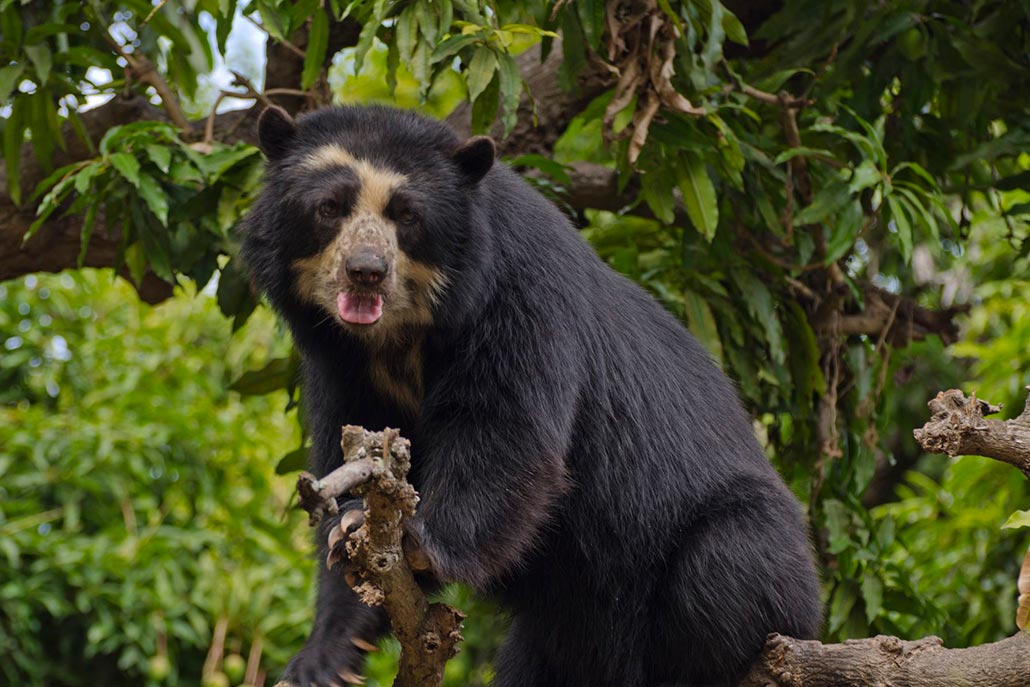
The spectacled bear ( tremarctos ornatus) is a mammal of the ‘ Ursidae‘ family (brown bear, panda bear, etc.) that is the only one in its species that inhabits the tropical mountainous territories of South America. Its name is due to the whitish spot on its face (similar to glasses), which however varies from one bear to another. The Incas used to hunt them for their meat. However, the real danger to its conservation occurred in the 20th century, after the deforestation of its territory and indiscriminate hunting.
Description
- Dimensions: The spectacled bear can reach a height of 1.8 meters (5.9 ft).
- Characteristics: It has black fur and a white spot (similar to glasses) on its face, although some bears they do not present any stain. They also have a large head in relation to the body. They can climb trees and get on two legs. Males are larger than females.
- Lifespan: it can live 50 years in its natural habitat and 30 years in captivity.
- Habitat: The eastern (tropical) part of the Andes Mountains of South America (Venezuela, Colombia, Ecuador, Bolivia, Argentina and Peru).
- Behavior: Spectacled bears have solitary habits. It usually roams the woods at night. The female usually gives birth to two cubs after 8 months of gestation.
- Food: They are omnivores but preferably feed on plants and fruits. You can also eat fish, rodents, honey, eggs, reptiles, rabbits.
- Reproduction: Bears do not have a seasonal mating period so they can reproduce in any time of the year. The male and female usually spend weeks together for copulation. Then they separate.
- Threats: Spectacled bear is in ‘Vulnerable’ conservation status due to illegal hunting as well as the deterioration of their environment.
Habitat in Cusco
- The spectacled bear is one of the illustrious visitors to Machu Picchu. It is estimated that in the Sanctuary Historic Machu Picchu there are 20 bears, in an area of approximately 32 thousand hectares.
The spectacled bear in Machu Picchu
- On some occasions, tourists can see spectacled bears in the Inca City of Machu Picchu. Most of the time this animal travels the high parts of the place and then returns to more remote areas. These animals are usually passive if they are not disturbed. Until now no type of attack has been reported, an accident with spectacled bears in Machu Picchu.
Cock-of-the-rocks
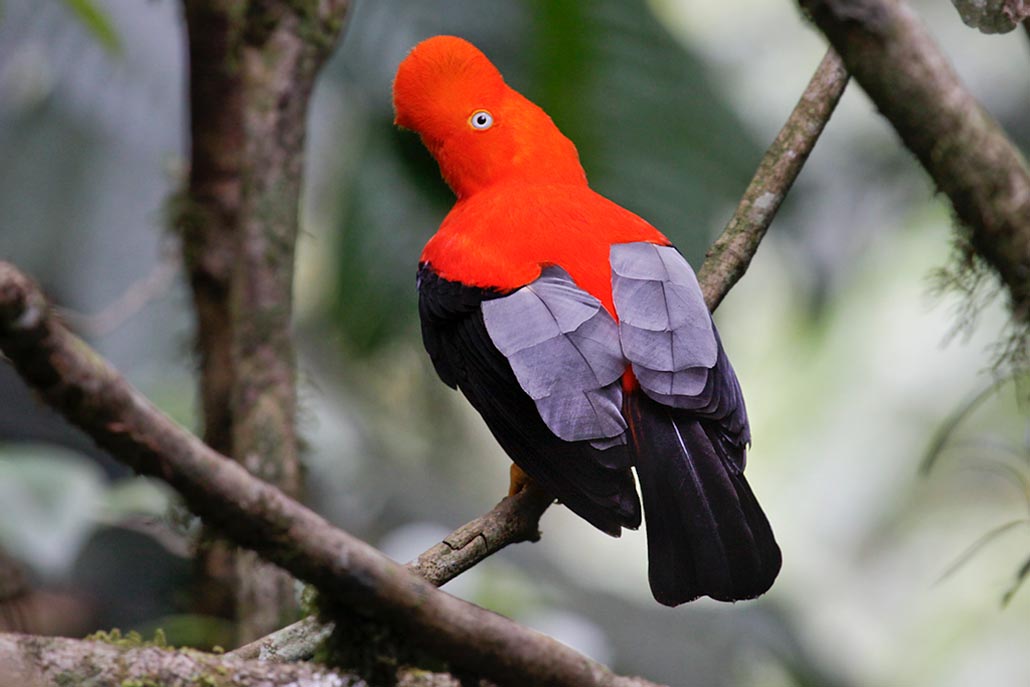
The cock-of-the-rock (rupicola peruvianus) is a species of bird that inhabits the mountainous jungles of South America. It is considered the national bird of Peru due to the beauty of its reddish and black plumage. It also inhabits the territories of Venezuela, Colombia and Ecuador. The male has colorful feathers while the female has a duller color without the characteristics of the former.
The Incas also valued Tunqui (name of the cock of the rocks in Quechua, the language of the Incas). During the Inca Trail it is common to observe These birds perch on the trees. Today, this bird is hunted indiscriminately because of its high value in the illegal market. Its conservation status is of ‘least concern’.
Description
- Dimensions: The cock-of-the-rocks is a medium-sized bird. It reaches a height of 32 centimeters (1 ft).
- Characteristics: The males have a very intense orange and black plumage (the females have a dull color). The head has a slight crest. Their legs are short but strong.
- Lifetime: The cock-of-the-rock has a lifetime in captivity or in its natural habitat of approximately 7 years.
- Habitat: The eastern (tropical) part of the Andes Mountains of South America (Venezuela, Colombia, Ecuador and Peru).
- Behavior: Cock-of-the-rocks are difficult birds to observe as they fly over rocks that are difficult access. They usually nest in the crevices of steep mountains.
- Food: They eat mainly fruits. This is because its natural habitat is surrounded by trees. whose best form of pollination is through birds such as the cock of the rocks.
- Reproduction: Males often use their colorful plumage and song to attract the female. The male dominant is who copulates first. Then the females make their nests in the mountain crevices. The incubation lasts approximately 40 days.
- Threats: The main predator of the cock-of-the-rock are eagles, hawk, snake, cougar and ferrets. The striking color of the male attracts predators so it is necessary inhabit the most inaccessible places in the jungle.
Habitat in Cusco
- In Peru, the cock of the rocks inhabits the jungles of San Martín, Pasco, Tingo María, Madre de God and Cusco.
- The cock of the rocks inhabits the mountainous jungles of Cusco.
- During the Inca Trail to Machu Picchu it is possible to see the cock of the rocks.
- In Vilcabamba, known as the ‘Lost City of the Incas’ it is also possible to see the Gallito from the rocks.
The orchids
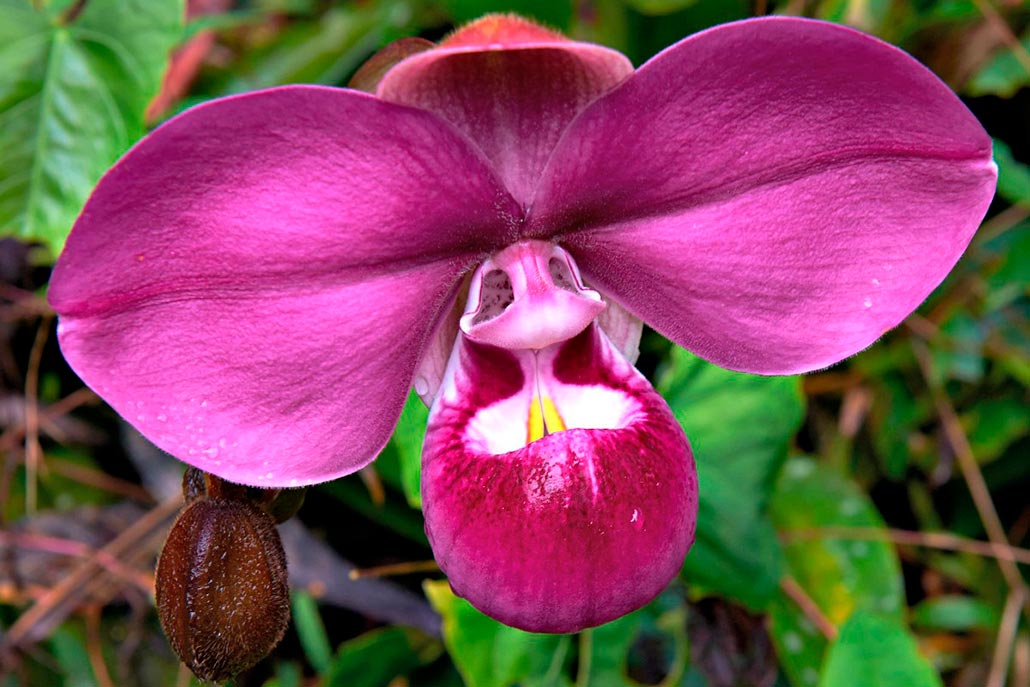
Orchids (orchidaceae) are the plant family with the greatest diversity of species (it is calculated up to 30 thousand) on the planet. Its flowers are distinguished by the beauty of their color as well as the symmetry of their petals. According to various investigations, orchids are more than 60 million old. They are in the most of the world, except in extreme cold and desert climates. Its size varies according to the species, being able to reach just a few millimeters or a height of up to 13 meters.
In Peru there are more than 3,000 species of orchids due to the great abundance of microclimates. Among the most striking are the ‘Sobralia altissima’, the tallest terrestrial orchid in the world (13 meters). Wave ‘Masdevallia veitchiana’, known as one of the most beautiful orchids in the world. The latter is present in an Inca oral tradition. Today, in Machu Picchu there are more than 400 species, some of which are in danger of extinction.
Description
- Root: There are tuberous roots (similar to tubers) as well as aerial roots attached to the stems of trees.
- Leaves: There is a great variety of leaves where the spiral, whorled, basal or simply scale-like leaves.
- Flowers: There is a great diversity of flowers, which nevertheless have the common trait of symmetry. Many species have spiral-shaped flowers with around a central axis.
- Fruits: The fruit of an orchid is a capsule and, rarely, an edible berry. The seeds they are small and fragile, so they can be dispersed with the wind.
- Colors: Orchids have many colors and shades standing out: red, yellow, orange, blue, green and purple.
- Sizes: The size varies by species. Tiny orchids smaller than 1 millimeter have been recorded (0.003 ft) tall like those of the genus ‘Platystele’. The largest is in Peru and is called ‘Sobralia altissima’, which reaches 13 meters in height (42 ft).
- Habitat: Present almost everywhere in the world (except in places with extreme climates). They are found in all continents except the desert of Australia, the desert north of Africa and the countries of polar climates.
- Pollination: Most flowers produce nectar, which makes pollination easier. Usually the flowering occurs once a year, depending on the climate and geography. For fertilization, Pollinators are needed (flies, bees, mosquitoes, birds, and more).
- Germination: The (tiny) seeds are dispersed by the wind. Germination requires a fungus. A pollinating agent is also necessary to disperse the seeds.
- Dangers: Indiscriminate deforestation is endangering the habitat of thousands of species of orchids.
Habitat in Cusco
- The mountainous jungles of Cusco are the habitat of many species of orchids. In recent years, New species of orchids were discovered in Cusco. For this reason, the Inca city is one of the preferred tourist destinations for plant watchers.
Orchids in Machu Picchu
- It is estimated that in the Historic Sanctuary of Machu Picchu there are more than 425 species of orchids.
- The Inca Trail is also the scene of many varieties of orchids.
- In 1942, the archaeological site ‘Wiñay Huayna’ (‘Always young’), whose name makes reference to a type of orchid abundant in that area around Machu Picchu.
Orchids and the Incas
- The Incas and the native cultures before the Incas gave great importance to orchids.
- The Cusco chronicler ‘Guamán Poma de Ayala’ mentioned in one of the pages of his’ New Chronicle and good government ‘that the Inca queen’ Chimbo Urma ‘was very beautiful and fond of collecting flowers ‘Ynquilcona’ (orchids).
- There is an Inca legend that explains the origin of the ‘Waqanki orchid, whose leaves have a dew characteristic. This legend tells of the love between an Inca princess and a commoner soldier. The Inca prohibited said love so he sent the soldier to a suicidal war. The Inca princess fled in search of her lover dropping tears on his way. From these tears the ‘Waqanki’ orchids bloomed, whose Quechua name means ‘tears’.
Kantu, the flower of the Incas
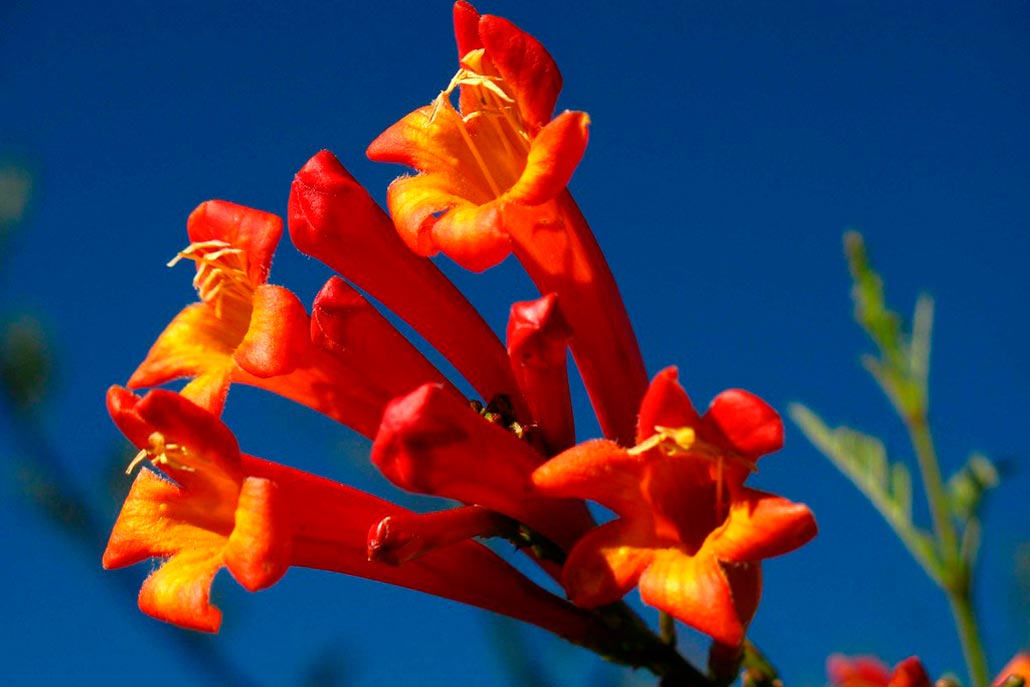
The cantuta flower (cantua buxifolia) is a species of plant native to the high Andean areas of Peru and Bolivia. It is precisely considered the ‘national flower of Peru’ and ‘one of the national flowers of Bolivia’. It is characterized by its tubular crown flowers and a pistil in the middle. Colors may vary but they preferably use red, pink, yellow and white. Its bush is bushy and branched with abundance of leaves.
The cantuta flower has been admired since pre-Inca times. According to oral tradition, when the Inca moved from one place to another during religious ceremonies, his subjects dropped flowers of cantuta in its wake. In addition, it is stated that the young people graduated from a ceremony where the cantuta it was used as an ornament on their heads. Today, the flower of the cantuta is considered as’ the flower of the Incas’. It continues to be a widely used ornamental flower.
Description
- Leaves: Small, rough and abundant. They have an elliptical shape and are green in color.
- Flowers: They have a very striking beauty. Although they do not have a distinguishable odor, it is highly valued ornamentally. The flowers grow at the end of the branches and are characterized by their tubular shape.
- Colors: Cantuta flowers have various shades of bright colors: red, pink, yellow and white.
- Sizes: The plant can reach a height of 2 to 3 meters. The cantuta flower is only a few centimeters long.
- Habitat: Present in the high Andean territories of Peru and Bolivia, between 1,200 meters at the level of the sea (3,937 ft) to 3,800 meters of sea level (12,467 ft).
- Pollination: Cantuta flowers have nectar and coloration that attract pollinators, especially hummingbirds and insects.
- Dangers: The cantuta flower is not in danger.
- Uses: The flower is used mainly for ornamental purposes. Its branches are also used for make baskets.
- Wood: The wood of the cantuta is used to make canes.
- Awards: ‘National flower of Peru’, ‘National flower of Bolivia’.
The sacred flower of the Incas
- The cantuta flower was considered sacred by the Incas due to its great beauty.
- It is said that the Inca emperor ordered the cultivation of the cantuta flower in the empire.
- The Incas used to include the cantuta flower in the most important religious rituals.
- In solemn moments, the Inca himself used to move on carpets made of cantuta flower.
- Young Incas graduated from the ‘Warachikuy’ ceremony by adorning their heads with the flower of cantuta.
Uses in Cusco today
- Currently, the cantuta flower is used as an ornament in the houses and gardens of the families of Peru, Bolivia and other countries that acquire this plant.
- In the burials of Cusco (especially during the last century), the cantuta flower was used in a belief that it quenched the thirst of the dead.
- In the towns of the altiplano (of Peru and Bolivia); the cantuta flower is used as a necklace in the doors of families. This means that the house offers hospitality to its visitors.
By Machupicchu Terra – Last updated, August 28, 2023